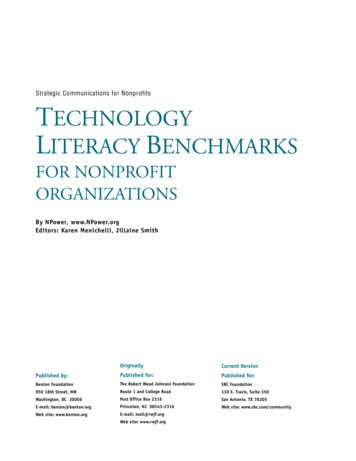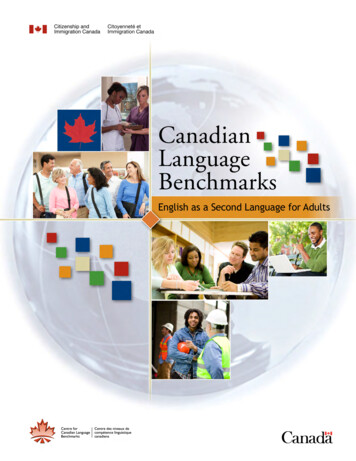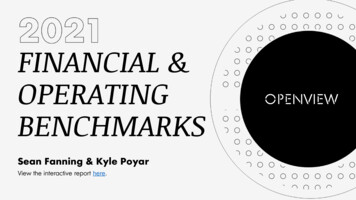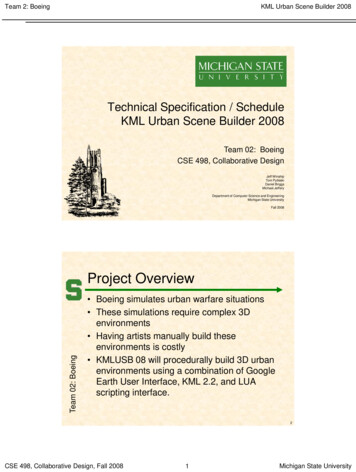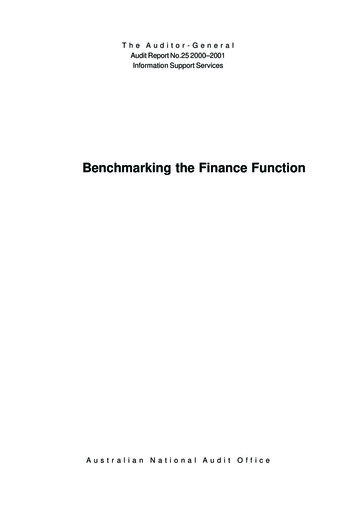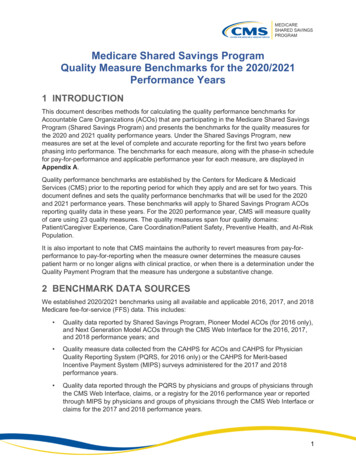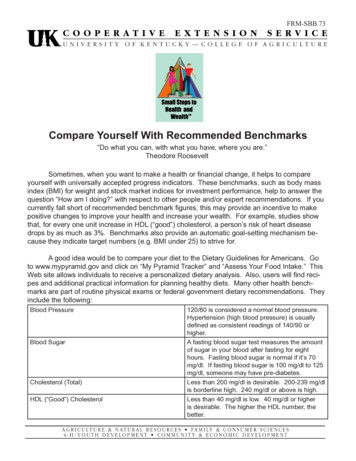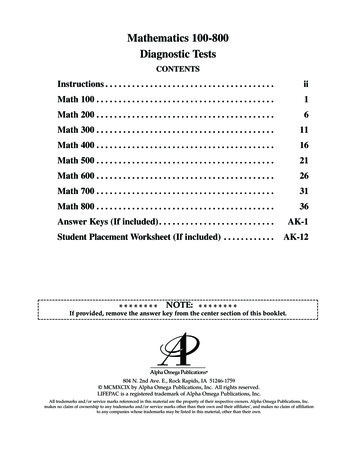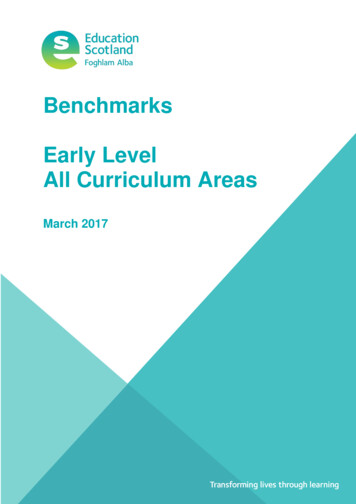
Transcription
BenchmarksEarly LevelAll Curriculum AreasMarch 2017
Education ScotlandGuidance on using Benchmarks for AssessmentMarch 2017Education Scotland’s Curriculum for Excellence (CfE) Statement for Practitioners(Aug 2016) stated that the two key resources which support practitioners to plan learning,teaching and assessment are: Experiences and OutcomesBenchmarksBenchmarks have been developed to provide clarity on the national standards expectedwithin each curriculum area at each level. They set out clear lines of progression in literacyand English and numeracy and mathematics, and across all other curriculum areas fromEarly to Fourth Levels (First to Fourth Levels in Modern Languages). Their purpose is tomake clear what learners need to know and be able to do to progress through the levels,and to support consistency in teachers’ and other practitioners’ professional judgements.Skills development is integrated into the Benchmarks to support greater sharedunderstanding. An understanding of skills and how well they are developing will enablelearners to make links between their current learning and their future career options andemployment.Benchmarks draw together and streamline a wide range of previous assessment guidance(including significant aspects of learning, progression frameworks and annotated exemplars)into one key resource to support teachers’ and other practitioners’ professional judgementof children’s and young people’s progress across all curriculum areas.Benchmarks have been designed to support professional dialogue as part of themoderation process to assess where children and young people are in their learning.They will help to support holistic assessment approaches across learning. They shouldnot be ticked off individually for assessment purposes.Benchmarks for literacy and numeracy should be used to support teachers’ professionaljudgement of achievement of a level. In other curriculum areas, Benchmarks supportteachers and other practitioners to understand standards and identify children’s andyoung people’s next steps in learning. Evidence of progress and achievement willcome from a variety of sources including: observing day-to-day learning within the classroom, playroom or working area; observation and feedback from learning activities that takes place in otherenvironments, for example, outdoors, on work placements; coursework, including tests; learning conversations; and planned periodic holistic assessment.2
Benchmarks in curriculum areasBenchmarks in each curriculum area are designed to be concise and accessible, withsufficient detail to communicate clearly the standards expected for each curriculum level.Teachers and other practitioners can draw upon the Benchmarks to assess the knowledge,understanding, and skills for learning, life and work which children are developing in eachcurriculum area.In secondary schools, Benchmarks can support subject specialist teachers in makingrobust assessments of learners’ progress and the standards they achieve. They willhelp teachers ensure that learners make appropriate choices and are presented at anappropriate level for National Qualifications in the senior phase. This can help avoidexcessive workload for teachers and unnecessary assessments for learners. For example,learners should have achieved relevant Fourth level Experiences and Outcomes beforeembarking on the National 5 qualifications. Schools should take careful account of thiswhen options for S4 are being agreed. Benchmarks should be used to help with theseimportant considerations.Literacy and numeracyIn literacy and numeracy, Benchmarks support teachers’ professional judgement ofachievement of a level. Teachers’ professional judgements will be collected and publishedat national, local and school levels. It is important that these judgements are robust andreliable. This can only be achieved through effective moderation of planning learning,teaching and assessment.Achievement of a level is based on teacher professional judgement, well informed by a widerange of evidence. Benchmarks should be used to review the range of evidence gatheredto determine if the expected standard has been achieved and the learner has: achieved a breadth of learning across the knowledge, understanding and skillsas set out in the experiences and outcomes for the level;responded consistently well to the level of challenge set out in the Experiencesand Outcomes for the level and has moved forward to learning at the next levelin some aspects; anddemonstrated application of what they have learned in new and unfamiliarsituations.It is not necessary for learners to demonstrate mastery of every individual aspect of learningwithin Benchmarks at a particular level and before moving on to the next level. However,it is important that there are no major gaps in children’s and young people's learning whenlooking across the major organisers in each curriculum area.3
Planning learning, teaching and assessment using the BenchmarksIn addition to the Curriculum for Excellence (CfE) Statement for Practitioners fromHM Chief Inspector of Education, August 2016 on the purpose and use of Benchmarks,teachers and other practitioners should note the following advice.KEY MESSAGES – WHAT TO DOKEY MESSAGES – WHAT TO AVOID Use literacy and numeracy Benchmarksto help monitor progress towardsachievement of a level, and to supportoverall professional judgement of whena learner has achieved a level. Avoid undue focus on individualBenchmarks which may resultin over-assessing or recordingof learners’ progress. Become familiar with other curriculumarea Benchmarks over time. Avoid the requirement to spend timecollating excessive evidence to assesslearners’ achievement. Use Benchmarks to help assess whetherlearners are making suitable progresstowards the national standards expectedand use the evidence to plan their next,challenging steps in learning.Discuss Benchmarks within andacross schools to achieve a sharedunderstanding of the national standardsexpected across curriculum areas. There is no need to provide curriculumlevel judgements in all curriculum areas– stick to literacy and numeracy. Do not create excessive or elaborateapproaches to monitoring and tracking. Do not assess Benchmarks individually.Plan periodic, holistic assessment ofchildren’s and young people’s learning. Do not tick off individual Benchmarks. 4
ContentsPageLiteracy and English6Numeracy and Mathematics11Literacy and Gàidhlig18Expressive Arts23Gaelic (Learners)26Health and Wellbeing (Food and Health)28Health and Wellbeing (Personal and Social Education)30Health and Wellbeing (Physical Education)32Religious Education in Roman Catholic Schools36Religious and Moral Education38Sciences40Social Studies44Technologies465
Early Level Literacy and EnglishListening and TalkingCurriculumOrganisersEnjoymentand choice- within a motivatingand challengingenvironmentdeveloping anawareness of therelevance of textsin my lifeTools for listeningand talking- to help me wheninteracting orpresenting withinand beyond myplace of learningExperiences and Outcomesfor planning learning, teachingand assessmentI enjoy exploring and playingwith the patterns and soundsof language, and can use whatI learn.LIT 0-01a / LIT 0-11a /LIT 0-20aBenchmarks to support practitioners’professional judgement I enjoy exploring and choosing stories and other texts to watch,read or listen to, and can share my likes and dislikes.LIT 0-01b / LIT 0-11bI enjoy exploring events andcharacters in stories and othertexts, sharing my thoughts indifferent ways.LIT 0-01cAs I listen and talk in differentsituations, I am learning to taketurns and am developing myawareness of when to talk andwhen to listen.LIT 0-02a / ENG 0-03a Hears and says patterns in words.Hears and says rhyming words and generates rhyme from a givenword.Hears and says the different single sounds made by letters.Hears and says letter blends/sounds made by a combination ofletters.Participates actively in songs, rhymes and stories.Chooses a story or other texts for enjoyment, making use of thecover, title, author and/or illustrator.Engages with and enjoys watching, reading or listening todifferent texts, including stories, songs and rhymes, and canshare likes and dislikes.Engages with stories and texts in different ways, for example,retelling/re-enacting stories and/or using puppets/props.Makes an attempt to take turns when listening and talking in avariety of contexts.Makes an attempt to use appropriate body language whenlistening to others, for example, eye contact.Listens and responds to others appropriately.Asks questions and responds relevantly to questions from others.Follows and gives simple instructions.Shares ideas with a wider audience, for example, group or class.6
Listening and TalkingFinding and usinginformation- when listening to,watching and talkingabout texts withincreasingly complexideas, structures andspecialist vocabularyUnderstanding,analysing andevaluating- investigating and/orappreciating texts withincreasingly complexideas, structures andspecialist vocabularyfor different purposesCreating texts- applying the elementsothers use to createdifferent types of shortand extended texts withincreasingly complexideas, structures andvocabularyI listen or watch for useful or interesting information and I use this to make choicesor learn new things.LIT 0-04aUnderstands and responds to spoken texts.Identifies new or interesting information from spoken texts.To help me understand stories and other texts, I ask questionsand link what I am learning with what I already know.LIT 0-07a / LIT 0-16a /ENG 0-17aAsks and answers questions about texts to show and supportunderstanding.Makes simple predictions about texts.Within real and imaginary situations, I share experiencesand feelings, ideas and information in a way thatcommunicates my message.LIT 0-09a Talks clearly to others in different contexts, sharing feelings,ideas and thoughts.Recounts experiences, stories and events in a logical sequencefor different purposes.Communicates and shares stories in different ways, for example,in imaginative play.Uses new vocabulary and phrases in different contexts, forexample, when expressing ideas and feelings or discussing atext. I enjoy exploring events andcharacters in stories and othertexts and I use what I learn toinvent my own, sharing thesewith others in imaginative ways.LIT 0-09b / LIT 0-31aAs I listen and take part inconversations and discussions, Idiscover new words and phraseswhich I use to help me expressmy ideas, thoughts and feelings.LIT 0-10a7
ReadingEnjoymentand choice- within a motivatingand challengingenvironmentdevelopingan awarenessof the relevanceof texts in my lifeI enjoy exploring and playing with the patterns and soundsof language and can use what I learn.LIT 0-01a / LIT 0-11a /LIT 0-20aTools for reading- to help me use textswith increasinglycomplex or unfamiliarideas, structures andvocabulary within andbeyond my place oflearningI explore sounds, letters andwords, discovering how theywork together, and I can usewhat I learn to help me asI read and write.ENG 0-12a / LIT 0-13a /LIT 0-21aI enjoy exploring and choosingstories and other texts to watch,read or listen to, and can sharemy likes and dislikes.LIT 0-01b / LIT 0-11b Finding and usinginformation- when readingand using fiction andnon-fiction texts withincreasingly complexideas, structures andspecialist vocabularyChooses a story or other texts for enjoyment making use of thecover, title, author and/or illustrator.Engages with and enjoys watching, reading or listening todifferent texts, including stories, songs and rhymes, and canshare likes and dislikes.I use signs, books or other texts to find useful or interesting information and I use this toplan, make choices or learnnew things.LIT 0-14aHears and says patterns in words.Hears and says the different single sounds made by letters.Hears and says blends/sounds made by a combination of letters.Knows the difference between a letter, word and numeral.Reads from left to right and top to bottom.Uses knowledge of sounds, letters and patterns to read words.Uses knowledge of sight vocabulary/tricky words to read familiarwords in context.Reads aloud familiar texts with attention to simple punctuation.Uses context clues to support understanding of different texts.Finds information in a text to learn new things.Shows an awareness of a few features of fiction and non-fictiontexts when using/choosing texts for particular purposes.8
Writing Understanding,analysing andevaluatinginvestigating and/orappreciating fiction andnon-fiction texts withincreasingly complexideas, structures andspecialist vocabularyfor different purposesTo help me understand storiesand other texts, I ask questionsand link what I am learning withwhat I already know.LIT 0-07a / LIT 0-16a /ENG 0-17aEnjoymentand choice- within a motivatingand challengingenvironmentdeveloping anawareness of therelevance of textsin my lifeTools for writing- using knowledgeof technical aspectsto help my writingcommunicateeffectively withinand beyond myplace of learningI enjoy exploring and playing with the patterns and soundsof language and can use whatI learn.LIT 0-01a / LIT 0-11a /LIT 0-20a I enjoy exploring events and characters in stories and othertexts, sharing my thoughts in different ways.LIT 0-19aI explore sounds, letters andwords, discovering how theywork together, and I can usewhat I learn to help meas I read or write.ENG 0-12a / LIT 0-13a /LIT 0-21aAs I play and learn, I enjoyexploring interesting materialsfor writing and different ways ofrecording my experiences andfeelings, ideas and information.LIT 0-21b Engages with texts read to them.Asks and answers questions about events and ideas in a text.Answers questions to help predict what will happen next.Contributes to discussions about events, characters and ideasrelevant to the text.Shares thoughts and feelings about stories and other texts indifferent ways.Retells familiar stories in different ways, for example, role play,puppets and/or drawings.Relates information and ideas from a text to personalexperiences.Writes for enjoyment, exploring patterns and sounds, in a rangeof play, imaginative and real contexts.Forms most lowercase letters legibly.Uses a pencil with increasing control and confidence.Knows the sounds of lowercase and some uppercase letters.Leaves a space between words when writing.Writes words from left to right.Makes an attempt to spell familiar words correctly.Makes an attempt to use a capital letter and a full stop in at leastone sentence.9
Organising andusing information- considering texts tohelp create short andextended texts fordifferent purposesWithin real and imaginary situations, I share experiencesand feelings, ideas and information in a way thatcommunicates my message.LIT 0-26aWrites to convey ideas, messages and information in differentways in play, imaginative and real contexts.Writes to reflect own experiences and feelings using appropriatevocabulary to convey meaning.Creating texts- considering texts tohelp create short andextended texts fordifferent purposesI enjoy exploring events and characters in stories and othertexts and I use what I learn to invent my own, sharing thesewith others in imaginative ways.LIT 0-09b / LIT 0-31aInvents own stories and characters to share with others in play,imaginative and real contexts.Shares feelings, experiences, information, messages or ideas inpictures, print or digital texts.10
Early Level Numeracy and MathematicsNumber, money and measure*CurriculumOrganisersEstimationand roundingNumber andnumber processesExperiences and Outcomesfor planning learning, teachingand assessmentI am developing a sense of size andamount by observing, exploring,using and communicating with othersabout things in the world around me.MNU 0-01aI have explored numbers,understanding that they representquantities, and I can use themto count, create sequencesand describe order.MNU 0-02aI use practical materials and can‘count on and back’ to help meunderstand addition and subtraction,recording my ideas and solutionsin different ways.MNU 0-03aBenchmarks to support teachers’ andpractitioners’ professional judgement Recognises the number of objects in a group, withoutcounting (subitising) and uses this information to estimatethe number of objects in other groups.Checks estimates by counting.Demonstrates skills of estimation in the contexts of numberand measure using relevant vocabulary, including lessthan, longer than, more than and the same.Explains that zero means there is none of a particularquantity and is represented by the numeral 0.Recalls the number sequence forwards within the range 0 30, from any given number.Recalls the number sequence backwards from 20.Identifies and recognises numbers from 0 to 20.Orders all numbers forwards and backwards within therange 0 - 20.Identifies the number before, the number after and missingnumbers in a sequence within 20.Uses one-to-one correspondence to count a given numberof objects to 20.Identifies ‘how many?’ in regular dot patterns, for example,arrays, five frames, ten frames, dice and irregular dotpatterns, without having to count (subitising).Groups items recognising that the appearance of the grouphas no effect on the overall total (conservation of number).Uses ordinal numbers in real life contexts, for example, ‘Iam third in the line’.Uses the language of before, after and in-between.Counts on and back in ones to add and subtract.11
Multiples, factorsand primesPowers and rootsFractions, decimalfractions andpercentagesMoneyTimeDoubles numbers to a total of 10 mentally.When counting objects, understands that the number nameof the last object counted is the name given to the totalnumber of objects in the group.Partitions quantities to 10 into two or more parts andrecognises that this does not affect the total.Adds and subtracts mentally to 10.Uses appropriately the mathematical symbols , and .Solves simple missing number problems.There are no experiences and outcomes There are no experiences and outcomes at early level.at early level.There are no experiences and outcomes There are no experiences and outcomes at early level.at early level. Splits a whole into smaller parts and explains that equalI can share out a group of items byparts are the same size.making smaller groups and can split Uses appropriate vocabulary to describe halves.a whole object into smaller parts. Shares out a group of items equally into smaller groups.MNU 0-07aI am developing my awareness of howmoney is used and can recognise anduse a range of coins.MNU 0-09aI am aware of how routines and eventsin my world link with times andseasons, and have explored waysto record and display these usingclocks, calendars and other methods.MNU 0-10a Identifies all coins to 2.Applies addition and subtraction skills and uses 1p, 2p, 5pand 10p coins to pay the exact value for items to 10p. Links daily routines and personal events to timesequences.Names the days of the week in sequence, knows themonths of the year and talks about features of the fourseasons in relevant contexts.Recognises, talks about and where appropriate, engageswith everyday devices used to measure or display time,including clocks, calendars, sand timers and visualtimetables.Reads analogue and digital o’clock times (12 hour only)and represents this on a digital display or clock face.Uses appropriate language when discussing time, 12
including before, after, o’clock, hour hand and minutehand.MeasurementI have experimented with everydayitems as units of measure toinvestigate and compare sizesand amounts in my environment,sharing my findings with others.MNU 0-11a Shape, positionand movementMathematics – itsimpact on the world,past, present andfuturePatterns andrelationshipsExpressions andequationsPropertiesof 2D shapesand 3D objectsAngle, symmetryand transformationThere are no experiences and outcomesat early level.Shares relevant experiences in which measurements oflengths, heights, mass and capacities are used, forexample, in baking.Describes common objects using appropriatemeasurement language, including tall, heavy and empty.Compares and describes lengths, heights, mass andcapacities using everyday language, including longer,shorter, taller, heavier, lighter, more and less.Estimates, then measures, the length, height, mass andcapacity of familiar objects using a range of appropriatenon-standard units.There are no experiences and outcomes at early level.I have spotted and explored patterns in Copies, continues and creates simple patterns involving objects,my own and the wider environment andshapes and numbers.can copy and continue these and create Explores, recognises and continues simple number patterns.my own patterns. Finds missing numbers on a number line within the range 0 - 20.MTH 0-13aThere are no experiences and outcomes There are no experiences and outcomes at early level.at early level.I enjoy investigating objects and shapes Recognises, describes and sorts common 2D shapes and 3Dand can sort, describe and be creativeobjects according to various criteria, for example, straight, round,with them.flat and curved.MTH 0-16aIn movement, games, and using Understands and correctly uses the language of position andtechnology I can use simple directionsdirection, including in front, behind, above, below, left, right,and describe positions.forwards and backwards, to solve simple problems in movementgames.MTH 0-17a13
Information handlingData and analysisI have had fun creating a range ofsymmetrical pictures and patternsusing a range of media.MTH 0-19aI can collect objects and askquestions to gather information,organising and displayingmy findings in different ways.MNU 0-20aI can match objects, and sort usingmy own and others’ criteria, sharingmy ideas with others.MNU 0-20bIdeas of chanceand uncertainty Identifies, describes and creates symmetrical pictures with oneline of symmetry. Asks simple questions to collect data for a specificpurpose.Collects and organises objects for a specific purpose.Applies counting skills to ask and answer questions andmakes relevant choices and decisions based on the data.Contributes to concrete or pictorial displays where oneobject or drawing represents one data value, using digitaltechnologies as appropriate.Uses knowledge of colour, shape, size and other propertiesto match and sort items in a variety of different ways.Interprets simple graphs, charts and signs anddemonstrates how they support planning, choices anddecision making. I can use the signs and charts aroundme for information, helping me planand make choices and decisionsin my daily life.MNU 0-20cThere are no experiences and outcomes There are no experiences and outcomes at early level.at early level.The statements in bold and italics in both the Experiences and Outcomes and the Benchmarks are the responsibility of all and as such,evidence from across the curriculum should be considered when making judgements about achieving a level.* Curriculum organisers in some previous documents have been referred to as sub-division14
Numeracy and Mathematical skillsNumeracy and mathematical skills are embedded in the Experiences and Outcomes and cannot be taught in isolation. These skills can bedeveloped through careful planning of learning activities, questions and a range of assessments. These should encourage learners to thinkabout the concepts, going beyond the recall of knowledge and encouraging them to explain their thinking. As learners progress throughCurriculum for Excellence levels, they should demonstrate increasing sophistication and independence in their ability to demonstrate, link,transfer and apply the following skills in a range of increasingly more challenging contexts: interpret questions; select and communicate processes and solutions; justify choice of strategy used; link mathematical concepts; use mathematical vocabulary and notation; use mental agility; reason algebraically; and determine the reasonableness of a solution.The table below provides a brief outline of the key features of each skill.KeyNumeracy andfeaturesmathematicalof theskillskillInterpretquestions selects the relevant informationinterprets datahighlights key words or phrasesmakes notesdraws diagramschooses appropriate operations.Additional guidanceLearners need to: interpret questions successfully in order to work outsolutions; select relevant information and be able to identifyredundant or missing information in a question; interpret data and understand information presentedto work out the solution; be supported to develop their skills of interpretingquestions by highlighting key words or phrases,making notes or drawing diagrams; and make important decisions about which operations tochoose when solving a word problem.15
Select andcommunicateprocesses andsolutions Learners need to:explains choice of processshares thinkingverbalises or demonstratesthought processes. Justify choiceof strategyused be able to explain why they have chosen a particularprocess as it demonstratestheir understanding of the task, question or assessment;have frequent opportunities to discuss their thinking withtheir peers and teachers;select from a range of processes and increasingly chooseprocesses which are most efficient;discuss their solutions to verbalise their thought process,either through explaining their thinking or demonstrating itpictorially; andbecome more confident in their abilities to select from agrowing repertoire of strategies, articulate their chosenapproaches with increasing clarity and make greater useof specialised vocabulary.Learners need to:shows and talks thoughtheir thinkingexplains their strategyjustifies choice of strategycompared to other approaches. show and talk through their thinking to better understandand explain their own strategies;regularly work in pairs and groups to learn with and fromeach other to refine their strategies; andjustify their choice of strategy, identifying the most efficientstrategies for different typesof task.Learners need to:Linkmathematicalconcepts understands and applies linksbetween mathematicalconceptstransfers learning inone area to another be able to link mathematical concepts through inverseoperations and equivalences; andtransfer and apply their knowledge and skills withinnumeracy and mathematicsand across the curriculum to solve a range of problems.uses connectionsto solve problems.16
Learners need to:Usemathematicalvocabulary andnotation uses correct mathematicalvocabulary apply the correct mathematical vocabulary, notation andappropriate units in a range of contexts.Learners need to:Mental agility knowledge of number factsmanipulates numbers. develop fluency in mental processes through a soundknowledge of key number facts; and use strategies to manipulate an appropriate range ofnumbers and apply these to solve open-endedproblems.Learners need to:Reasonalgebraically finds the unknown quantityunderstands and uses thecommutative, associative anddistributive laws. understand that numbers can be replaced by pictures orsymbols and use this to solve problems; andapply commutative, associative and distributive laws towork with expressions and equations.Learners need to:Determine thereasonablenessof a solution routinely uses estimation androunding skillsselects the most appropriatedegree of accuracy. use estimation and rounding to estimate and check thereasonableness of a solution;consider the context of the question when determining thereasonableness of the solution; andselect the appropriate degree of accuracy for the giventask.17
Early Level Literacy and GàidhligListening and TalkingCurriculum OrganisersEnjoymentand choice- within a motivatingand challengingenvironment developingan awarenessof the relevanceof texts in my lifeExperiences and Outcomesfor planning learning, teachingand assessmentI enjoy exploring and playingwith the patterns and soundsof language, and can use whatI learn.LIT 0-01a / LIT 0-11a /LIT 0-20aI enjoy exploring and choosingstories and other texts to watch,read or listen to, and can sharemy likes and dislikes.LIT 0-01b / LIT 0-11bI enjoy exploring events andcharacters in stories and othertexts, sharing my thoughtsin different ways.LIT 0-01cBenchmarks to support practitioners’ professional judgement Tools forlisteningand talking- to help me wheninteracting or presentingwithin and beyond myplace of learningAs I listen and take part inconversations, I discover newwords and phrases. I use theseto help talk to, play and workwith others.GAI 0-02a 18Participates in and recalls songs, rhymes and stories whichsupport the learning of Gaelic language in a total immersionsetting.Listens to stories to help learn Gaelic, recognising andrepeating familiar words and phrases, answering questionson the content with a decreasing reliance on English, usingan appropriate range of strategies to support their acquiringfluency.Recognises / uses / repeats with accuracy words and phrasesin Gaelic and demonstrates understanding through responses.Identifies the different single sounds and the sounds madeby a combination of letters of the Gaelic alphabet, for examplemh, bh, th, str.Identifies sounds learned within words.Listens and responds to stories and other texts, sharing likesand dislikes using Gaelic words and phrases.Discusses characters and events in stories, songs, role-playand texts in different ways, for example, using role-play andusing puppets.Expresses an opinion on a range of texts in different ways,for example, using actions.Listens to, demonstrates an understanding of and repeats newwords and phrases from the use of Gaelic in a total immersionsetting across a variety of contexts. The learner is becomingconfident in their use of Gaelic in social situations androutines, such as
Benchmarks have been developed to provideclarity on the national standards expected within each curriculum area at each level. They set out clear lines of progression in literacy


